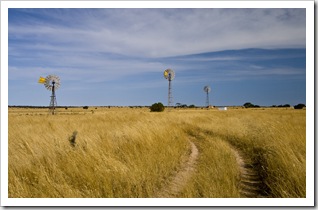
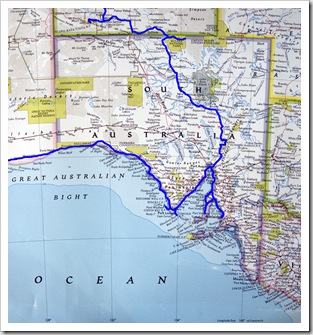 I forgot to mention one of the highlights of the Nullarbor Plain as we came across a few days ago: the longest golf course in the world. Stretched across a couple of thousand kilometers, the Nullarbor Golf Links has a hole at each town and a few scenic sights along the plain. It’d be a long 18 holes! After finishing our trek across the Nullarbor the first town in South Australia is Penong, a small farming settlement on the far west coast of the Eyre Peninsula. We shot down to Cape LeHunte, home of the famous Cactus Beach, to camp for the night. The waves were pretty tepid when we stopped for the night but there were still a few surfers about. We could tell that
I forgot to mention one of the highlights of the Nullarbor Plain as we came across a few days ago: the longest golf course in the world. Stretched across a couple of thousand kilometers, the Nullarbor Golf Links has a hole at each town and a few scenic sights along the plain. It’d be a long 18 holes! After finishing our trek across the Nullarbor the first town in South Australia is Penong, a small farming settlement on the far west coast of the Eyre Peninsula. We shot down to Cape LeHunte, home of the famous Cactus Beach, to camp for the night. The waves were pretty tepid when we stopped for the night but there were still a few surfers about. We could tell that 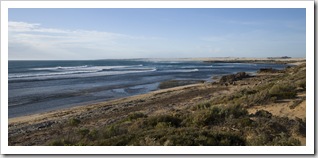 with a bit of swell it would be quite a spot to catch a wave at one of the three famous breaks: Cactus, Caves or Castles. Definitely an interesting bathroom experience for us at the Cactus campsite: the toilets were basically garbage bins with a heavy duty plastic bag inside and a toilet seat on top, together with a bag of lime and shovel to be used afterwards! The jetty at Cape LeHunte was a nice protected spot for a bit of fishing, I snagged a small squid while Lisa explored the surrounding point and tide pools.
with a bit of swell it would be quite a spot to catch a wave at one of the three famous breaks: Cactus, Caves or Castles. Definitely an interesting bathroom experience for us at the Cactus campsite: the toilets were basically garbage bins with a heavy duty plastic bag inside and a toilet seat on top, together with a bag of lime and shovel to be used afterwards! The jetty at Cape LeHunte was a nice protected spot for a bit of fishing, I snagged a small squid while Lisa explored the surrounding point and tide pools.
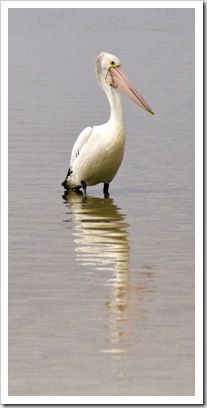
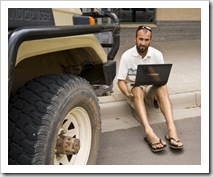
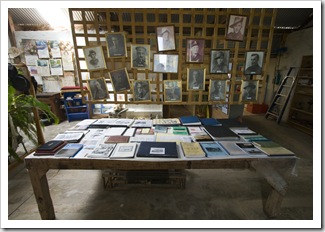 On our way out of Penong we stopped off at the town’s Woolshed Museum, a collection of farming and household artifacts from yesterday but definitely not a patch on Margaret Brown’s collection on Yorke Peninsula (more on that later…). We continued along the Great Australian Bight through Ceduna, where we quickly checked our email and stopped off at the visitor centre before spending the night at the Streaky Bay Caravan Park. We both enjoyed Streaky Bay (S32°47.785′ E134°11.848′) a lot, a great atmosphere and a another fantastic country pub
On our way out of Penong we stopped off at the town’s Woolshed Museum, a collection of farming and household artifacts from yesterday but definitely not a patch on Margaret Brown’s collection on Yorke Peninsula (more on that later…). We continued along the Great Australian Bight through Ceduna, where we quickly checked our email and stopped off at the visitor centre before spending the night at the Streaky Bay Caravan Park. We both enjoyed Streaky Bay (S32°47.785′ E134°11.848′) a lot, a great atmosphere and a another fantastic country pub 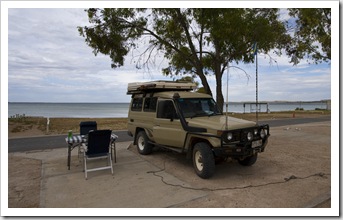 where we spent the afternoon with a few beers overlooking the bay. It was great to see that there are still a few old-world pubs in South Australia where one can get a pint for $5.00 and a good counter meal for under $15.00. Lisa sampled some of the local King George Whiting and I tucked into a schnitzel, something that the Western Australians are still figuring out how to cook properly… The bar staff at the Streaky Bay Pub were quite impressed with seeing a Californian waltzing around in some local R.M. Williams garb and it was great to be able to catch the tail end of the West Indies/Australia test match from Adelaide. If you’re reading this and ever find yourself in Streaky Bay, the caravan park kiosk on the foreshore is the cheapest place you’ll find fresh oysters anywhere on Eyre Peninsula: $5.00 a dozen. Elliotts Bakery is similarly worth a stop, fantastic baked goods and coffees, another addition to my list of Australia’s Best Bakeries.
where we spent the afternoon with a few beers overlooking the bay. It was great to see that there are still a few old-world pubs in South Australia where one can get a pint for $5.00 and a good counter meal for under $15.00. Lisa sampled some of the local King George Whiting and I tucked into a schnitzel, something that the Western Australians are still figuring out how to cook properly… The bar staff at the Streaky Bay Pub were quite impressed with seeing a Californian waltzing around in some local R.M. Williams garb and it was great to be able to catch the tail end of the West Indies/Australia test match from Adelaide. If you’re reading this and ever find yourself in Streaky Bay, the caravan park kiosk on the foreshore is the cheapest place you’ll find fresh oysters anywhere on Eyre Peninsula: $5.00 a dozen. Elliotts Bakery is similarly worth a stop, fantastic baked goods and coffees, another addition to my list of Australia’s Best Bakeries.
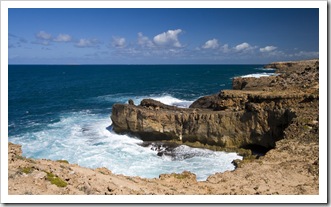
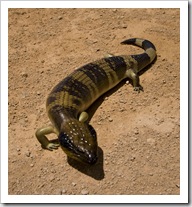
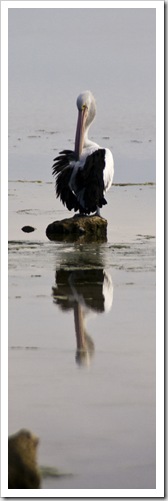 We spent a morning exploring the striking coastline southwest of Streaky Bay, some brilliant vistas and seriously powerful seas. The loop around Cape Bauer was well worth the detour, as was the drive we took around the scenic Westall Way. South of the settlements of Sceale Bay and Fisherman’s Paradise is Point Labatt, home to Australia’s largest New Zealand Fur Seal colony. The Australian Sea-Lions and New Zealand Fur Seals were strewn all over the granite rocks at the base of the cliffs of Point Labatt, quite
We spent a morning exploring the striking coastline southwest of Streaky Bay, some brilliant vistas and seriously powerful seas. The loop around Cape Bauer was well worth the detour, as was the drive we took around the scenic Westall Way. South of the settlements of Sceale Bay and Fisherman’s Paradise is Point Labatt, home to Australia’s largest New Zealand Fur Seal colony. The Australian Sea-Lions and New Zealand Fur Seals were strewn all over the granite rocks at the base of the cliffs of Point Labatt, quite 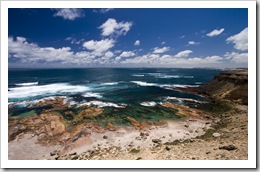 content to spend the day leisurely sun-baking between meals. From Point Labatt we drove around the nearby bay and south to the sleepy seaside settlement of Baird Bay, the tourist pamphlet made Baird Bay sound like a coastal utopia but we left town within five minutes of arriving after seeing the swampy marshes that passed as beaches and the fact that the town’s campsite is a parking lot on the side of the highway! Next was Port Kenny a little further
content to spend the day leisurely sun-baking between meals. From Point Labatt we drove around the nearby bay and south to the sleepy seaside settlement of Baird Bay, the tourist pamphlet made Baird Bay sound like a coastal utopia but we left town within five minutes of arriving after seeing the swampy marshes that passed as beaches and the fact that the town’s campsite is a parking lot on the side of the highway! Next was Port Kenny a little further 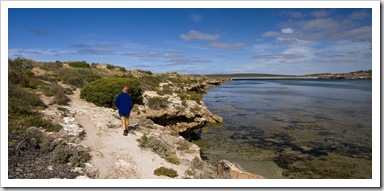 down the Eyre, where the bar staff laughed at me when I asked if there was a campsite in town… We ended up
down the Eyre, where the bar staff laughed at me when I asked if there was a campsite in town… We ended up 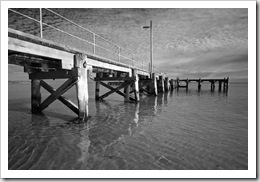 stumbling onto the sleepy holiday town of Venus Bay (S33°13.974′ E134°40.466′), nestled on the protected side of the small peninsula
stumbling onto the sleepy holiday town of Venus Bay (S33°13.974′ E134°40.466′), nestled on the protected side of the small peninsula 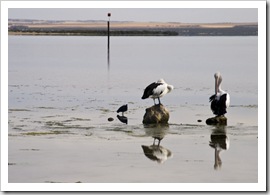
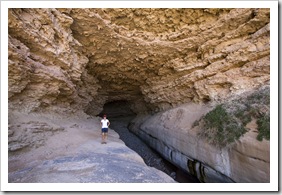 forming the opening to Venus Bay itself. There were no campsites at Venus Bay but the caravan park is in a brilliant location on the secluded waters of the Venus Bay inlet, within walking distance of the town’s jetty and the South Head Walking Trail. I spent the afternoon fishing off the jetty and pulled in some handsome-sized squid, we ate more fresh calamari that night than I think either of us had ever consumed in a single sitting! A morning walk along the South Head Walking Trail took us longer than expected after we spent the better part of half an hour watching pods of dolphins frolic in the crystal clear water in the mouth of Venus Bay’s inlet. Some of them came within 20 or 30 meters of where we were standing on the cliffs, so close that we could hear them exhaling when they surfaced. Great to see them up so close in the wild. From Venus Bay we stopped off at Talia Caves, taking a walk into the cavernous Woolshed cave, as well as a quick peek at the town of Elliston (add one more to Australia’s Best Bakeries) on our way to Coffin Bay at the southern tip of the Eyre Peninsula.
forming the opening to Venus Bay itself. There were no campsites at Venus Bay but the caravan park is in a brilliant location on the secluded waters of the Venus Bay inlet, within walking distance of the town’s jetty and the South Head Walking Trail. I spent the afternoon fishing off the jetty and pulled in some handsome-sized squid, we ate more fresh calamari that night than I think either of us had ever consumed in a single sitting! A morning walk along the South Head Walking Trail took us longer than expected after we spent the better part of half an hour watching pods of dolphins frolic in the crystal clear water in the mouth of Venus Bay’s inlet. Some of them came within 20 or 30 meters of where we were standing on the cliffs, so close that we could hear them exhaling when they surfaced. Great to see them up so close in the wild. From Venus Bay we stopped off at Talia Caves, taking a walk into the cavernous Woolshed cave, as well as a quick peek at the town of Elliston (add one more to Australia’s Best Bakeries) on our way to Coffin Bay at the southern tip of the Eyre Peninsula.
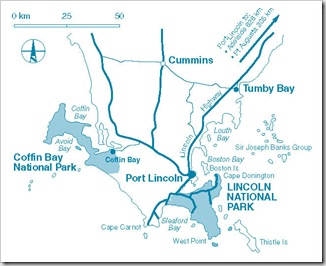
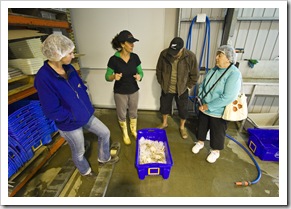 The tip of the Eyre Peninsula boasts a couple of brilliant National Parks, the majority of Coffin Bay and Lincoln National Parks are 4WD-only affairs so we enjoyed putting The Tank through its paces with a few days in each. Port Lincoln (S34°43.722′ E135°53.055′) was a great spot, the first time we’d seen a hint of traffic for quite some time. Port Lincoln could have been South Australia’s capital had the settlers been able to locate acceptable water supplies, there are some very interesting tourist attractions revolving around the town’s seafood industry. We took a tour of one of the local seafood processors, where we saw King George Whiting being filleted at a rate of about one fish every 10
The tip of the Eyre Peninsula boasts a couple of brilliant National Parks, the majority of Coffin Bay and Lincoln National Parks are 4WD-only affairs so we enjoyed putting The Tank through its paces with a few days in each. Port Lincoln (S34°43.722′ E135°53.055′) was a great spot, the first time we’d seen a hint of traffic for quite some time. Port Lincoln could have been South Australia’s capital had the settlers been able to locate acceptable water supplies, there are some very interesting tourist attractions revolving around the town’s seafood industry. We took a tour of one of the local seafood processors, where we saw King George Whiting being filleted at a rate of about one fish every 10 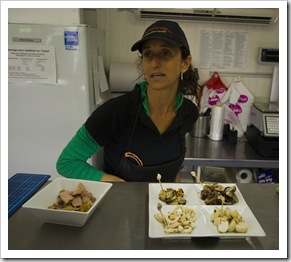 seconds and massive steaks of shark being sliced up for the state’s fish and chip shops. Our tour culminated with a sampling of some smoked local fare: calamari, oysters,
seconds and massive steaks of shark being sliced up for the state’s fish and chip shops. Our tour culminated with a sampling of some smoked local fare: calamari, oysters, 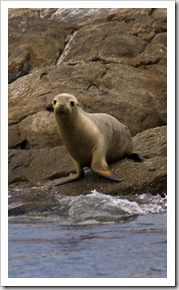 Kingfish, mussels and scallops. So good! We also took a tour cruise around Boston Harbour with Triple Bay Charters, the company has approval from some of the local Kingfish farmers to visit the farm nets, awesome to see 30,000 sashimi-grade swimmers up so close. Our cruise also stopped-in on an Australian Sea-Lion colony inhabiting one of the islands near Cape Donington, the pups were very playful, their parents and grandparents always keeping a watchful eye and trying to make sure they didn’t come too close to our boat. Our cruise and very knowledgeable captain gave us an idea of the immense size of the fishing industry in Port Lincoln. The town has the most millionaires per capita of any town in Australia! The big money is in prawns, Bluefin Tuna and Kingfish.
Kingfish, mussels and scallops. So good! We also took a tour cruise around Boston Harbour with Triple Bay Charters, the company has approval from some of the local Kingfish farmers to visit the farm nets, awesome to see 30,000 sashimi-grade swimmers up so close. Our cruise also stopped-in on an Australian Sea-Lion colony inhabiting one of the islands near Cape Donington, the pups were very playful, their parents and grandparents always keeping a watchful eye and trying to make sure they didn’t come too close to our boat. Our cruise and very knowledgeable captain gave us an idea of the immense size of the fishing industry in Port Lincoln. The town has the most millionaires per capita of any town in Australia! The big money is in prawns, Bluefin Tuna and Kingfish.
Prawning is a heavily regulated fishery, the fisherman net 58 days a year at times scheduled by the state fisheries department. We learned that it’s nigh on impossible to buy a fresh prawn in South Australia as all of them are snap frozen on the boats when caught. The Bluefin Tuna harvest is also very heavily regulated by an international body which determines how much Bluefin can be caught per year by each country targeting the sought-after fish. This year the Port Lincoln fishermen have been allotted 4000 tonnes of the lucrative fish. There are only a few commercial Bluefin licenses in South Australia, controlled by individuals who setup the industry decades ago. No more licenses will be created so each is worth quite a bit of money: some license 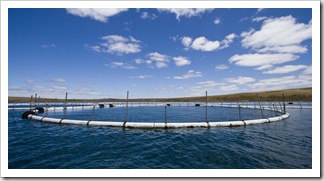
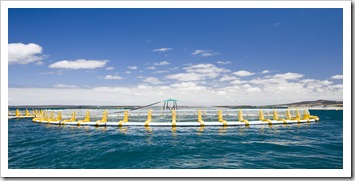 holders lease out their licenses for between $8MM and $12MM per year, and when one does change hands it has recently been for more than $180MM per license! While the tuna fishermen in Port Lincoln call it ‘farming’, the industry is more like ‘fattening’: the Bluefin are caught in nets in the Spencer Gulf and Great Australian Bight,
holders lease out their licenses for between $8MM and $12MM per year, and when one does change hands it has recently been for more than $180MM per license! While the tuna fishermen in Port Lincoln call it ‘farming’, the industry is more like ‘fattening’: the Bluefin are caught in nets in the Spencer Gulf and Great Australian Bight, 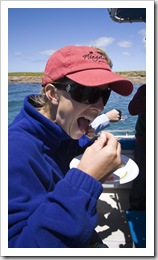 transported back to Port Lincoln and then fed Pilchards until they gain
transported back to Port Lincoln and then fed Pilchards until they gain 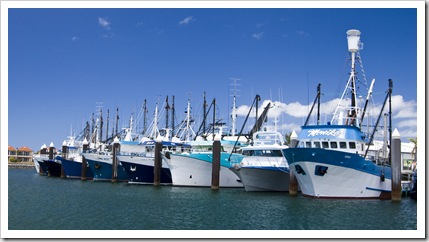 approximately 40% of their body weight before being harvested. When initially caught the schools of fish are spotted from the air, the pilots of the spotting planes are able to determine the approximate weight of the school and individual fish size by sight alone. The fish are captured in giant nets and towed back to Port Lincoln at a rate of 0.5 knots (roughly one kilometer per hour), the journey can sometimes take two months! It might sound a ludicrously slow speed, but there are Department of Fisheries observers on each boat and any dead or escaped fish go against each boat’s quota. At north of $1500 per fish, with some of the choicest cuts selling for more than $2000 per kilogram once
approximately 40% of their body weight before being harvested. When initially caught the schools of fish are spotted from the air, the pilots of the spotting planes are able to determine the approximate weight of the school and individual fish size by sight alone. The fish are captured in giant nets and towed back to Port Lincoln at a rate of 0.5 knots (roughly one kilometer per hour), the journey can sometimes take two months! It might sound a ludicrously slow speed, but there are Department of Fisheries observers on each boat and any dead or escaped fish go against each boat’s quota. At north of $1500 per fish, with some of the choicest cuts selling for more than $2000 per kilogram once 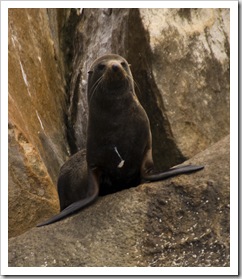 on the plate, it’s a little easier to understand the slow speed! Japanese chefs will fly to Port Lincoln to select their fish and Japanese observers will
on the plate, it’s a little easier to understand the slow speed! Japanese chefs will fly to Port Lincoln to select their fish and Japanese observers will 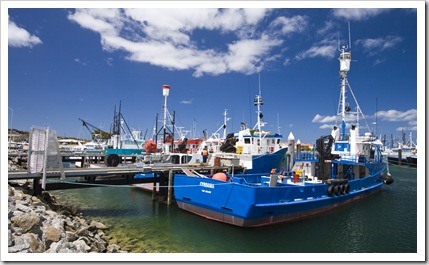 watch each fish being killed to ensure that the appropriate method is followed. When the fish are killed there are divers in the tuna nets with the fish, tuna can’t see behind them so the divers will wait for a fish to swim past and then quickly yank it backwards through the water by its tail. The backwards motion flushes the fish’s gills with water and stuns it for a few seconds, during which time the divers will insert their hands into the gills and clench the fish’s heart. The constriction of blood immobilizes the powerful tuna for a few more seconds, enough time to the divers to move the fish through the water and onto the kill platform.
watch each fish being killed to ensure that the appropriate method is followed. When the fish are killed there are divers in the tuna nets with the fish, tuna can’t see behind them so the divers will wait for a fish to swim past and then quickly yank it backwards through the water by its tail. The backwards motion flushes the fish’s gills with water and stuns it for a few seconds, during which time the divers will insert their hands into the gills and clench the fish’s heart. The constriction of blood immobilizes the powerful tuna for a few more seconds, enough time to the divers to move the fish through the water and onto the kill platform. 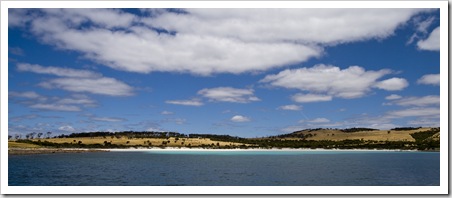 Once out of the water the fish is killed almost instantly with a metal stake through the brain, the brain removed via a corkscrew-like implement, a metal wire inserted down the backbone to remove the nervous system (which ensures the meat isn’t tainted with enzymes), and the guts removed via machine through the anus. The dead fish is then dipped in distilled water and immediately snap frozen to –65°C (-85°F), a temperature at which it can be kept for six years and still be served as sashimi. Each fish has an air filled bag inserted into its gut cavity and transported back to Japan in an individual cradle to preserve its shape. The time taken from the diver grabbing the fish to the distilled water dip is roughly 90 seconds, any longer than 3.5 minutes and the Japanese will not buy the fish, optimal time is 40 seconds. An amazing industry, we thoroughly enjoyed the wealth of information our tour skipper had to offer…
Once out of the water the fish is killed almost instantly with a metal stake through the brain, the brain removed via a corkscrew-like implement, a metal wire inserted down the backbone to remove the nervous system (which ensures the meat isn’t tainted with enzymes), and the guts removed via machine through the anus. The dead fish is then dipped in distilled water and immediately snap frozen to –65°C (-85°F), a temperature at which it can be kept for six years and still be served as sashimi. Each fish has an air filled bag inserted into its gut cavity and transported back to Japan in an individual cradle to preserve its shape. The time taken from the diver grabbing the fish to the distilled water dip is roughly 90 seconds, any longer than 3.5 minutes and the Japanese will not buy the fish, optimal time is 40 seconds. An amazing industry, we thoroughly enjoyed the wealth of information our tour skipper had to offer…
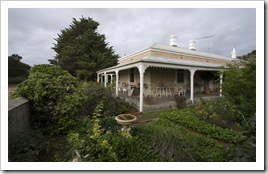
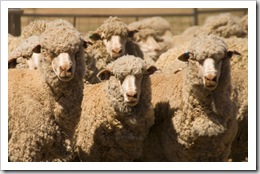
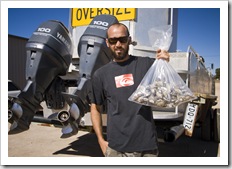 We stopped in at one of the local vintners, Boston Bay Wines, on our way out of town as we began our journey up the east coast of the Eyre. Along the way we ducked into Arno Bay and spent a night in another of the peninsula’s oyster-producing centers at Cowell (S33°41.124′ E136°55.593′). It was a fun Sunday
We stopped in at one of the local vintners, Boston Bay Wines, on our way out of town as we began our journey up the east coast of the Eyre. Along the way we ducked into Arno Bay and spent a night in another of the peninsula’s oyster-producing centers at Cowell (S33°41.124′ E136°55.593′). It was a fun Sunday 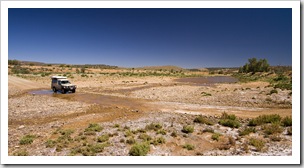
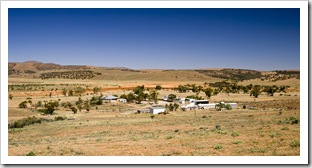 afternoon at Cowell’s two pubs, some of the bartenders were a real hoot, a good dose of country Aussie conversation! On our way out of Cowell we grabbed a few dozen export-quality oysters, hard to resist at $5.50 per dozen. We visited a family acquaintance’s sheep station in the southern Flinders Ranges as we rounded Spencer Gulf, a beautiful property with rivers, springs and some fantastic
afternoon at Cowell’s two pubs, some of the bartenders were a real hoot, a good dose of country Aussie conversation! On our way out of Cowell we grabbed a few dozen export-quality oysters, hard to resist at $5.50 per dozen. We visited a family acquaintance’s sheep station in the southern Flinders Ranges as we rounded Spencer Gulf, a beautiful property with rivers, springs and some fantastic 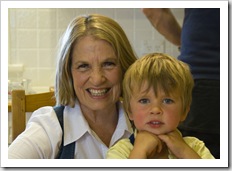 ranges running through it. We ran into a few of the 14,000 sheep penned up for a shearing the next day. Our last night in the tent for a while was in Mount Remarkable National Park in the Flinders Ranges, a beautiful campsite on the banks of Mambray Creek but we could have done without the worst swarms of mosquitoes we’ve experienced since leaving Adelaide in June. A few days with the Browns at their farm (S34°41.041′ E137°33.672′) near Minlaton on the Yorke Peninsula was a good chance to see the Brown kids and catch up with the rest of the family, Edward had just finished reaping when we arrived so we were lucky to be able to spend a rare bit of time with him whilst on the farm. Lunch with Jess Schulz and a few of her friends from high school at the Schulz farm near Maitland and it was back to Adelaide for a couple of weeks over Christmas. Whew, that’s half of the country done!
ranges running through it. We ran into a few of the 14,000 sheep penned up for a shearing the next day. Our last night in the tent for a while was in Mount Remarkable National Park in the Flinders Ranges, a beautiful campsite on the banks of Mambray Creek but we could have done without the worst swarms of mosquitoes we’ve experienced since leaving Adelaide in June. A few days with the Browns at their farm (S34°41.041′ E137°33.672′) near Minlaton on the Yorke Peninsula was a good chance to see the Brown kids and catch up with the rest of the family, Edward had just finished reaping when we arrived so we were lucky to be able to spend a rare bit of time with him whilst on the farm. Lunch with Jess Schulz and a few of her friends from high school at the Schulz farm near Maitland and it was back to Adelaide for a couple of weeks over Christmas. Whew, that’s half of the country done!
This entry was posted on Thursday, December 17th, 2009 at 11:30 AM and is filed under Australia, South Australia, Wines. You can follow any responses to this entry through the RSS 2.0 feed. Both comments and pings are currently closed.
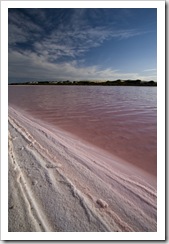
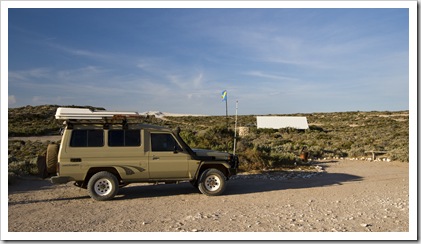
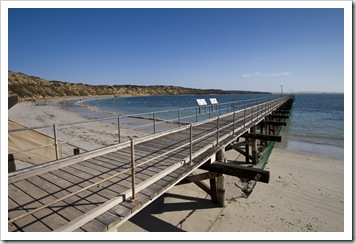
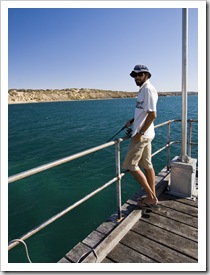
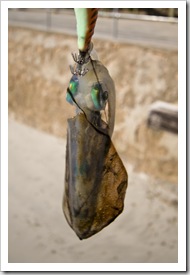
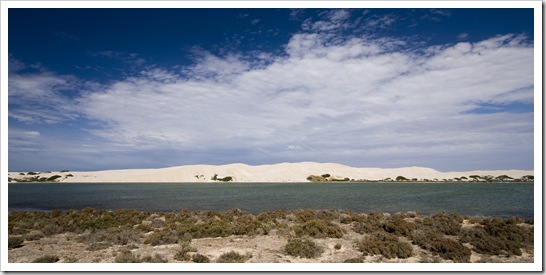
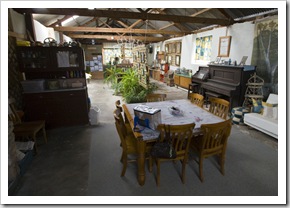
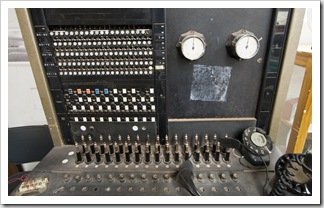
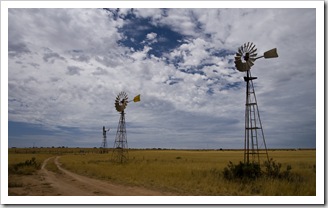
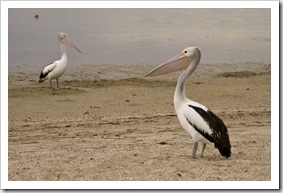
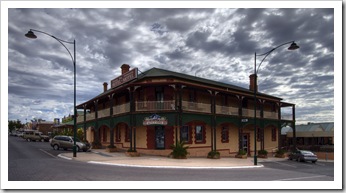
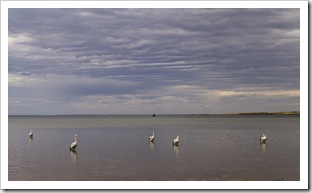
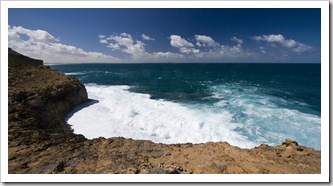
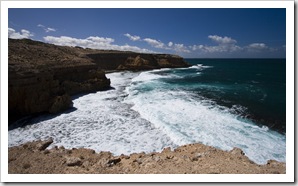
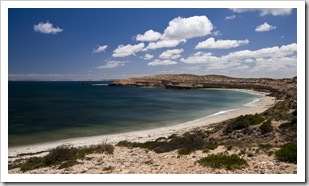
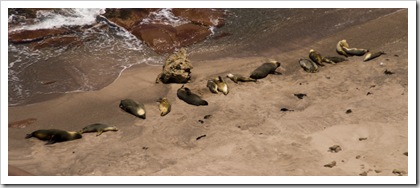
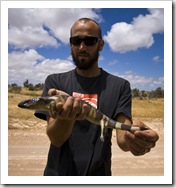
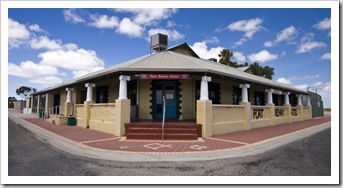
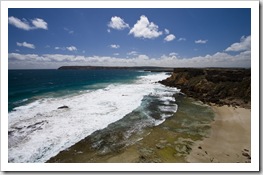
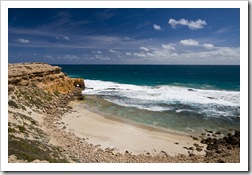
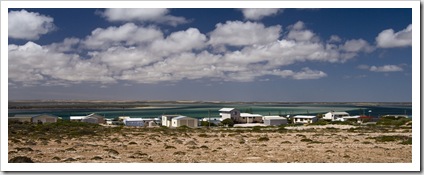
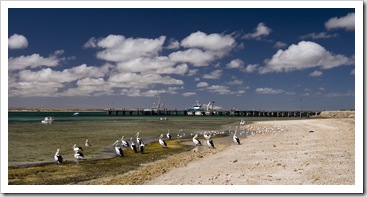
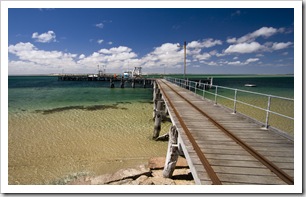
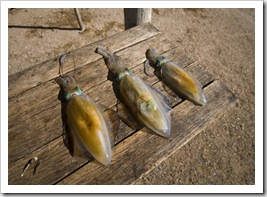
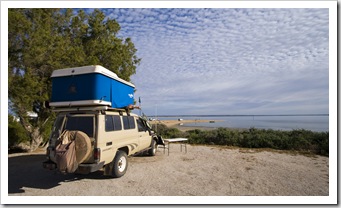
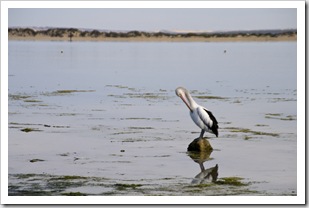
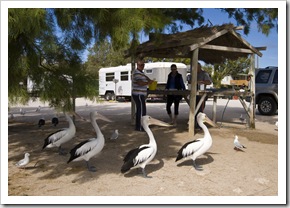
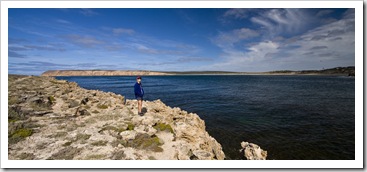
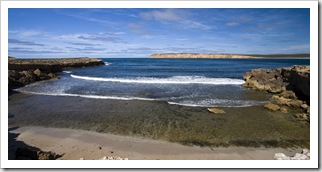
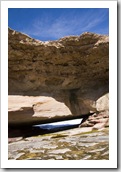
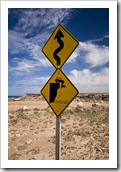
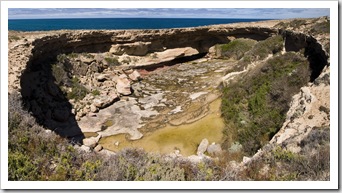
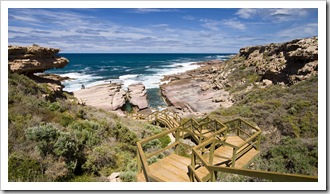
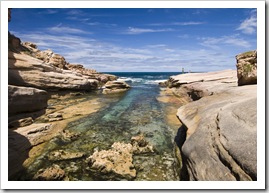
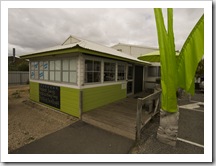
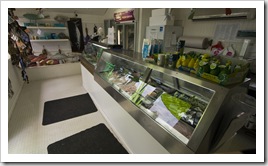
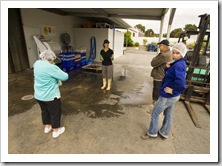
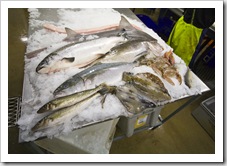
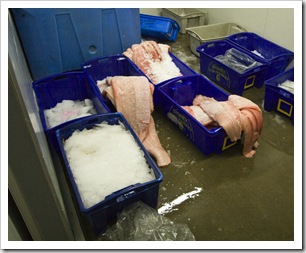
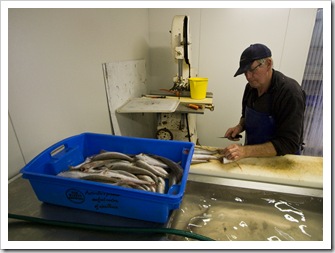
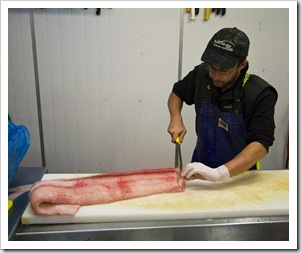
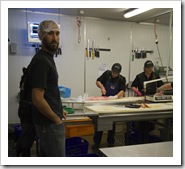
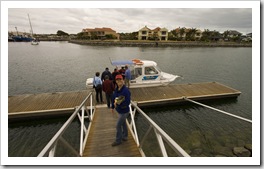
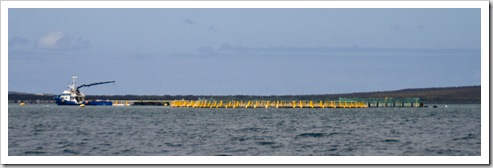
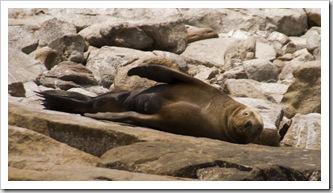
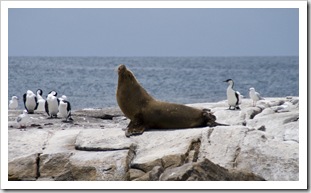
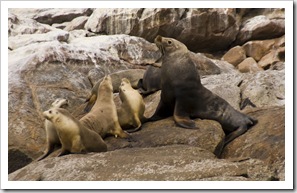
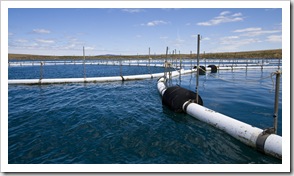
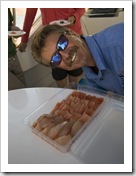
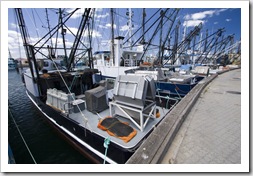
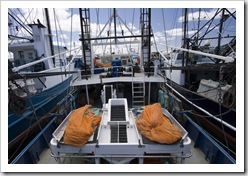
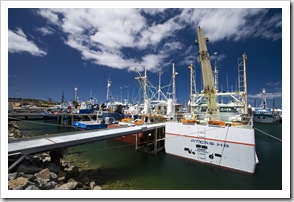
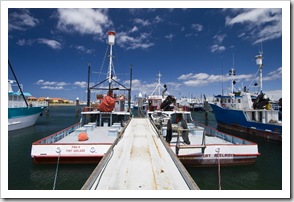
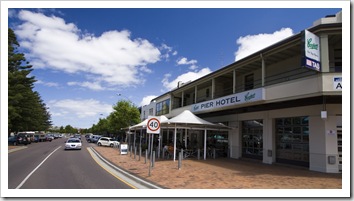
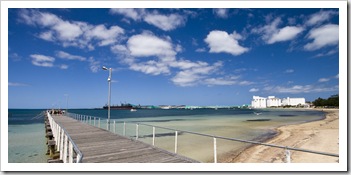
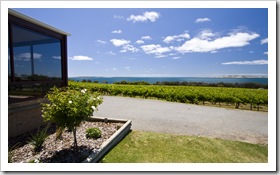
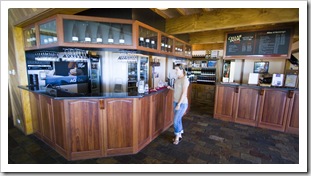
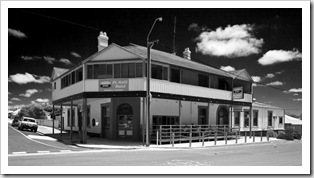
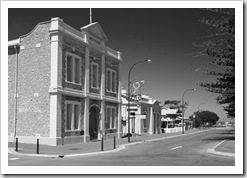
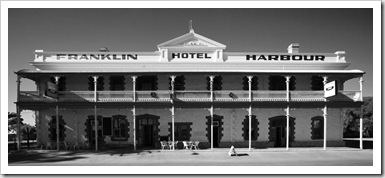
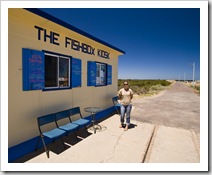
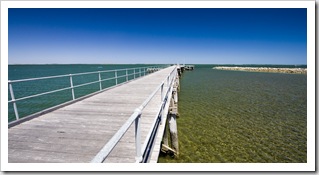
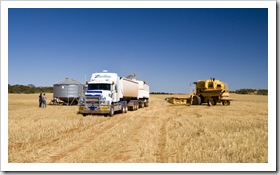
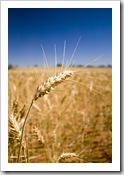
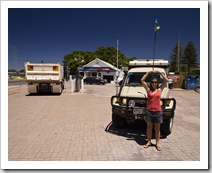
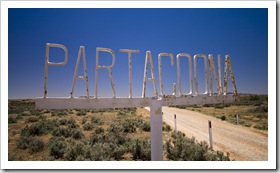
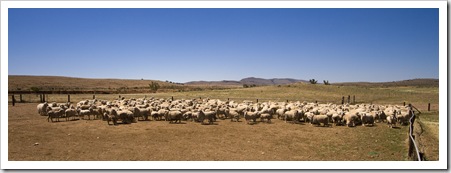
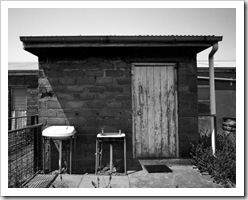
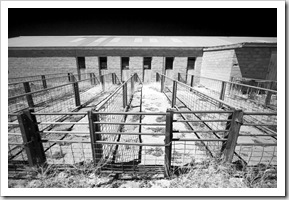
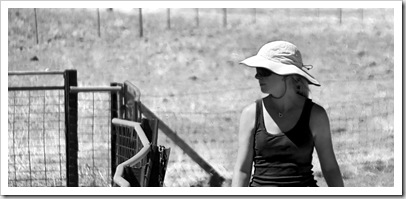
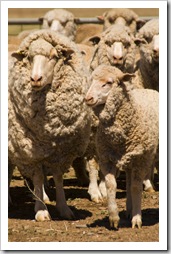
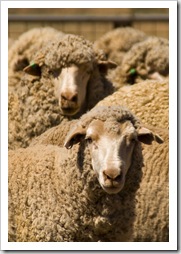
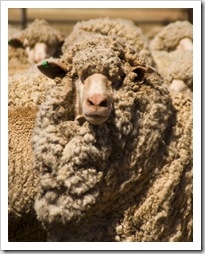
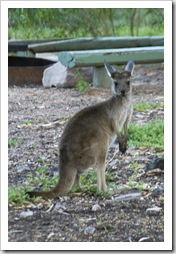
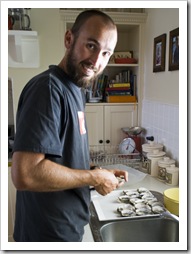
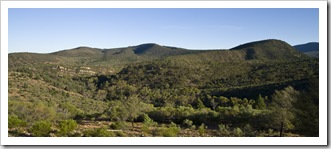
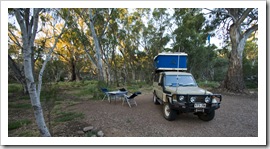
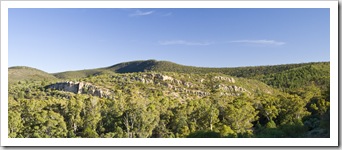
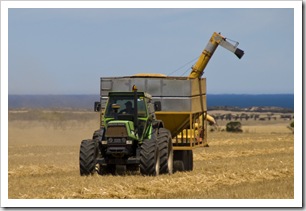
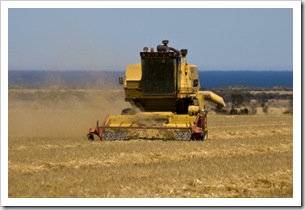
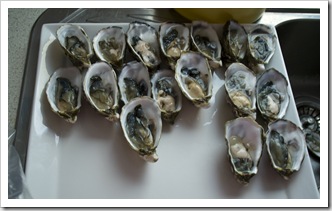
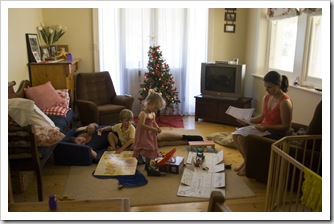
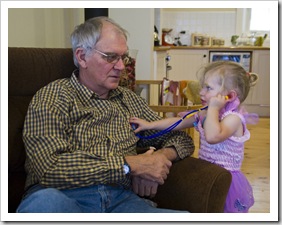
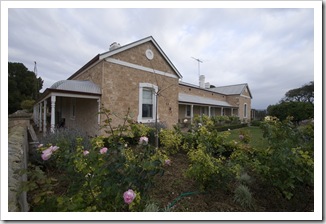

Hi Sam, this is really interesting re the tuna industry in Lincoln. I’ve never dealt with that industry, maybe I should get my skates on 180MM!! Wowee…
December 30th, 2009 at 2:51 PM
You really like picking up reptiles don’t you?
December 30th, 2009 at 7:22 PM
Great photos and story about the Eyre Peninsula. Thanks for the mention for Triple Bay Charters, Peter is recovering from a big op but i will be sure to show him when he gets out of hospital.
February 13th, 2010 at 3:10 PM
[…] crossing the Nullarbor Plain, and again when we were working our way down the west coast of the Eyre Peninsula in Streaky Bay. Wade and Michelle reside on the Sunshine Coast a few kilometers down the road […]
May 25th, 2010 at 3:26 PM
I have to say that for the past couple of hours i have been hooked by the impressive posts on this website. Keep up the wonderful work.
July 16th, 2012 at 1:47 PM